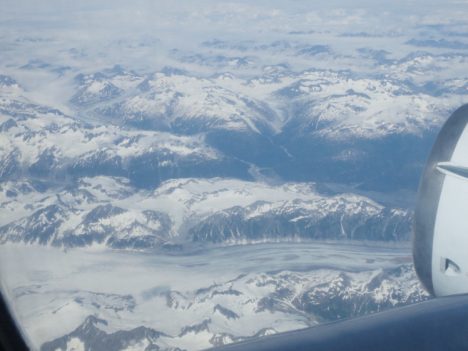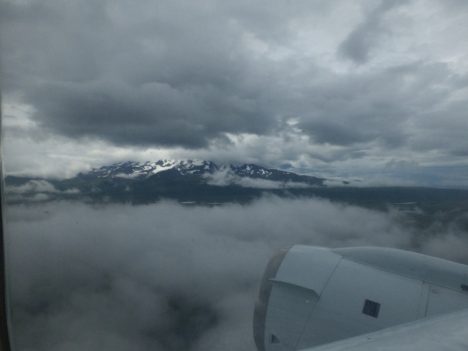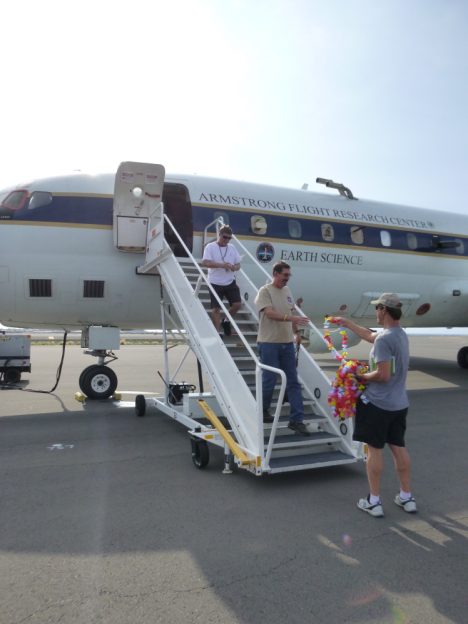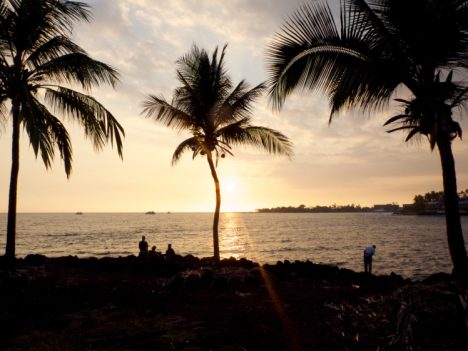
The DC-8 preparing to leave Anchorage, Alaska (credit: Christina Williamson).
We had a gently warm morning for takeoff to Hawaii, with sun peaking through the clouds. Getting above the clouds we had spectacular views of snow capped peaks. We made a missed approach at Cold Point, population 109 at the last census. Low clouds prevented us from seeing too much there visually, but through the instruments we saw that many chemical species were very low, perhaps because the air had been recently cleared by rain.

Mountain views leaving Anchorage, Alaska (credit: Christina Williamson).

Missed approach at Cold Point (credit: Christina Williamson)
We then flew over the Kodiak Archipelago, which I was told back in Anchorage is the place people go when Alaska feels too crowded! It looked very remote and intriguing.
From there it was pretty much a straight shot down the pacific to Hawaii, where we landed on the largest island, Kona. We passed through a ship track at one point, where we can clearly see the plume in lots of instruments, including the number of aerosol particles that I’m measuring. Other than that it feels quite featureless. It’s funny to go out and purposefully measure “almost -nothing”. It’s not nothing, its the atmospheric background and there’s always stuff going on, but its the kind of stuff I’ll only be able to see once I look at a lot of data together, finding patterns over space or correlations with other measured values. It may not be the most exciting data to report here, but in terms of our long-term understanding of atmospheric processes and rigorous testing of global climate models, it’s absolutely key.
We keep the cabin cool while we fly as it’s good for the instruments (although less comfortable for the humans). We knew Kona would be very humid, and if we just landed and opened the doors to let humid air in to condense on cold instruments we’d be in trouble, so we added heat in the last descent to stop this from happening.
It was indeed hot and humid when we landed. The ocean was a beautiful bright turquoise as we flew over it and the volcano was shrouded in mist. Our logistics manager had arrived before us and came onto the plane greeting each of us with traditional leis to welcome us.

Leis handed out by Dave Jordan (NASA AIMES) as we land in Kona, Hawaii (credit: Karl Froyd)
Wandering along the shore that evening to have dinner watching the sunset over a palm fringed beach it felt surreal that we had breakfasted in Alaska and seen so much in-between.

Palm trees on the shore on Kona, Hawaii (credit: Christina Williamson)
Christina Williamson blogs regularly about the ATom Mission and other adventures in atmospheric science at christinajwilliamson.wordpress.com and tweets as @chasingcloudsCW.




Interesting that you caught the exhaust plume from a ship. I worked twenty years in steamships and probably shoved more CO 2 into the atmosphere than any ten of my friends.